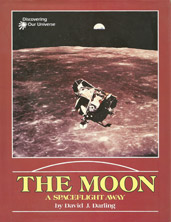THE MOON: A Spaceflight Away - 1. Our Spaceflight Begins

Earth and Moon, side by side.
Imagine it's the year 2030. From a spaceport near your home town, we've flown in a rocket-powered space plane hundreds of miles above the Earth. Now, inside an orbiting space station, we're waiting for the most exciting part of our journey to begin – a space flight to the Moon!
Some Facts and Figures
We've tried to learn as much as we can about the world we'll be visiting. The Moon is quite a bit smaller than the Earth. It's only 2,160 miles (3,476 kilometers) in diameter; compared with Earth's 7,928 miles (12,756 kilometers). If the Earth were the size of a basketball, the Moon would be no bigger than a baseball (see Figure 1).
But even though it's small, the Moon is special to us. It is the Earth's only natural satellite – the only object, not made by humans, that orbits, or moves around, our planet. At a distance of 238,900 miles (384,400 kilometers), it's also closer than the Sun or the planets. Because it's so close, the Moon seems big and bright in our sky.
To get an idea of how close the Moon really is, imagine that the whole solar system has been shrunk down. In this small scale, the distance from the Earth to the Sun is only 100 feet (about 30 meters). Now, remember, compared with most things in space, even the Sun is quite close by. But on the same scale, do you know how far from the Earth the Moon would be? Just 3 inches! The Moon is easily our closest neighbor in space.
The Moon is not a friendly world, though. It has no liquid water and no air. In fact, it has no atmosphere of any kind. During the day, its surface is hot enough to fry an egg. At night, it is colder than the North Pole. We will be visitors to a world where there has never been any life and where everything is strange and new.
Welcome Aboard
Soon our spaceship will be leaving. The captain welcomes us aboard and tells us that, traveling at several miles per second, it will take us less than a day to reach the Moon. By comparison, he says, the old Apollo craft took about four days to make the same journey.
We feel a steady, gentle push as the ship moves away from the space station and gradually gains speed. After about an hour, we reach cruising speed. Lunch is served, and then the captain announces today's in-flight movie, The Exploration of the Moon. The cabin lights dim, the film starts to roll, and the sound track begins ...

